小升初英语语法时态讲解与归纳
- 格式:docx
- 大小:22.66 KB
- 文档页数:10
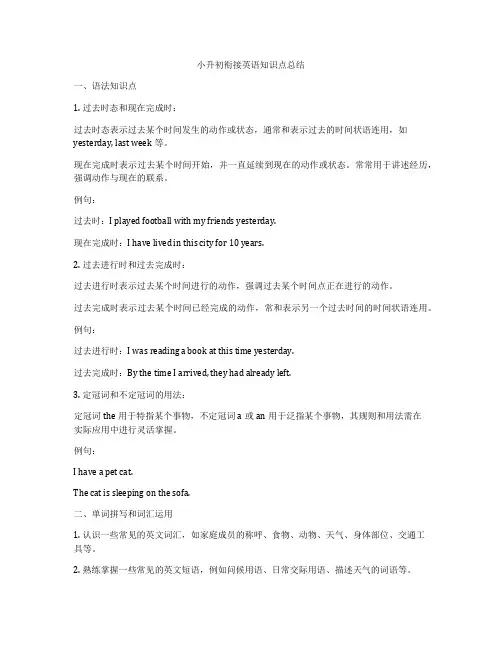
小升初衔接英语知识点总结一、语法知识点1. 过去时态和现在完成时:过去时态表示过去某个时间发生的动作或状态,通常和表示过去的时间状语连用,如yesterday, last week等。
现在完成时表示过去某个时间开始,并一直延续到现在的动作或状态。
常常用于讲述经历,强调动作与现在的联系。
例句:过去时:I played football with my friends yesterday.现在完成时:I have lived in this city for 10 years.2. 过去进行时和过去完成时:过去进行时表示过去某个时间进行的动作,强调过去某个时间点正在进行的动作。
过去完成时表示过去某个时间已经完成的动作,常和表示另一个过去时间的时间状语连用。
例句:过去进行时:I was reading a book at this time yesterday.过去完成时:By the time I arrived, they had already left.3. 定冠词和不定冠词的用法:定冠词the用于特指某个事物,不定冠词a或an用于泛指某个事物,其规则和用法需在实际应用中进行灵活掌握。
例句:I have a pet cat.The cat is sleeping on the sofa.二、单词拼写和词汇运用1. 认识一些常见的英文词汇,如家庭成员的称呼、食物、动物、天气、身体部位、交通工具等。
2. 熟练掌握一些常见的英文短语,例如问候用语、日常交际用语、描述天气的词语等。
3. 掌握一些常见的英文俚语和谚语,能够在日常生活中使用,更加接地气。
三、阅读理解能力1. 能够理解简单的英文文章和故事,提炼出文章的主旨和重要信息。
2. 能够根据文章内容回答问题,理解上下文的逻辑关系。
3. 能够理解一些常见的英文广告和宣传语,对其中的信息和宣传手法进行初步分析。
四、口语表达和听力能力1. 能够用英语进行简单的自我介绍,并且表达自己的基本情况、兴趣爱好、家庭情况等。
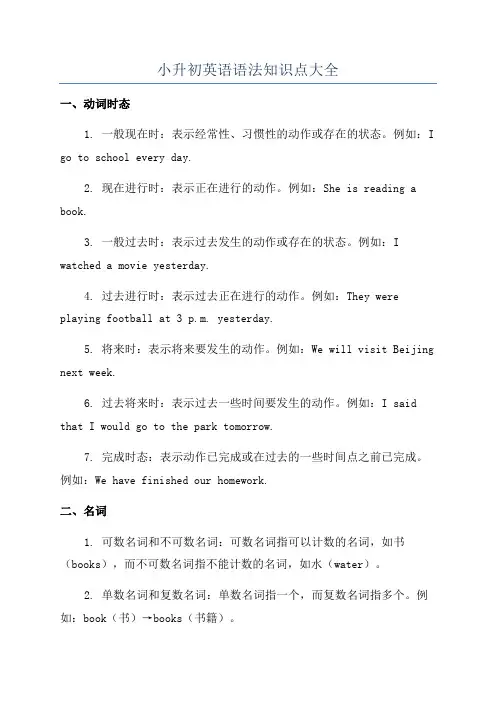
小升初英语语法知识点大全一、动词时态1. 一般现在时:表示经常性、习惯性的动作或存在的状态。
例如:I go to school every day.2. 现在进行时:表示正在进行的动作。
例如:She is reading a book.3. 一般过去时:表示过去发生的动作或存在的状态。
例如:I watched a movie yesterday.4. 过去进行时:表示过去正在进行的动作。
例如:They were playing football at 3 p.m. yesterday.5. 将来时:表示将来要发生的动作。
例如:We will visit Beijing next week.6. 过去将来时:表示过去一些时间要发生的动作。
例如:I said that I would go to the park tomorrow.7. 完成时态:表示动作已完成或在过去的一些时间点之前已完成。
例如:We have finished our homework.二、名词1. 可数名词和不可数名词:可数名词指可以计数的名词,如书(books),而不可数名词指不能计数的名词,如水(water)。
2. 单数名词和复数名词:单数名词指一个,而复数名词指多个。
例如:book(书)→books(书籍)。
3. 可数名词的复数形式:许多词在复数时需进行变位,如cat(猫)→cats(猫)、baby(婴儿)→babies(婴儿)。
4. 不可数名词的用法与数量表示:不可数名词无复数形式,不能与数词或a/an连用。
对于不可数名词表示的量,需使用量词或具体表示数量的词语,如a bottle of water、a cup of tea。
三、形容词和副词1. 形容词用法:形容词修饰名词,用来描述名词的性质或特征。
例如:a big dog(一只大狗)。
2. 形容词的比较级和最高级:形容词的比较级用于表示两个人或物之间的比较,如taller(更高),而最高级则用于表示三个或三个以上人或物之间的比较,如the tallest(最高的)。
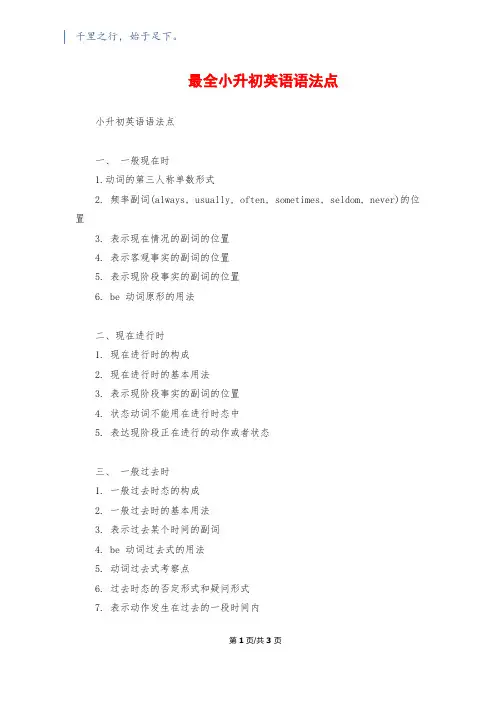
千里之行,始于足下。
最全小升初英语语法点小升初英语语法点一、一般现在时1.动词的第三人称单数形式2. 频率副词(always, usually, often, sometimes, seldom, never)的位置3. 表示现在情况的副词的位置4. 表示客观事实的副词的位置5. 表示现阶段事实的副词的位置6. be 动词原形的用法二、现在进行时1. 现在进行时的构成2. 现在进行时的基本用法3. 表示现阶段事实的副词的位置4. 状态动词不能用在进行时态中5. 表达现阶段正在进行的动作或者状态三、一般过去时1. 一般过去时态的构成2. 一般过去时的基本用法3. 表示过去某个时间的副词4. be 动词过去式的用法5. 动词过去式考察点6. 过去时态的否定形式和疑问形式7. 表示动作发生在过去的一段时间内第1页/共3页锲而不舍,金石可镂。
8. 常用的表示过去的时间四、现在完成时1. 现在完成时的构成2. 现在完成时的基本用法3. 表示延续到现在的时间段4. 表示完成的动作对现在的影响5. 表示动作发生在过去一段时间内或者有可能发生的时间6. yet 与 already 的用法7. just 的用法8. 特殊疑问句和一般疑问句的用法五、一般将来时1. 一般将来时的构成2. 一般将来时的基本用法3. 表示将来时间的状语4. 表示计划或意图5. 表示习惯或按照惯例6. be going to 的用法7. will 与 shall 的用法8. 表示即将发生或者肯定会发生六、时态混用1. 现在时与现在进行时的区别2. 过去时与现在完成时的区别3. 一般过去时与一般将来时的区别4. 现在进行时与将来进行时的区别七、动词时态1. 动词时态的定义和分类千里之行,始于足下。
2. 时态与语态的区别3. 时态的确定以上是小升初英语语法点的一些例子,希望对你有所帮助。
第3页/共3页。
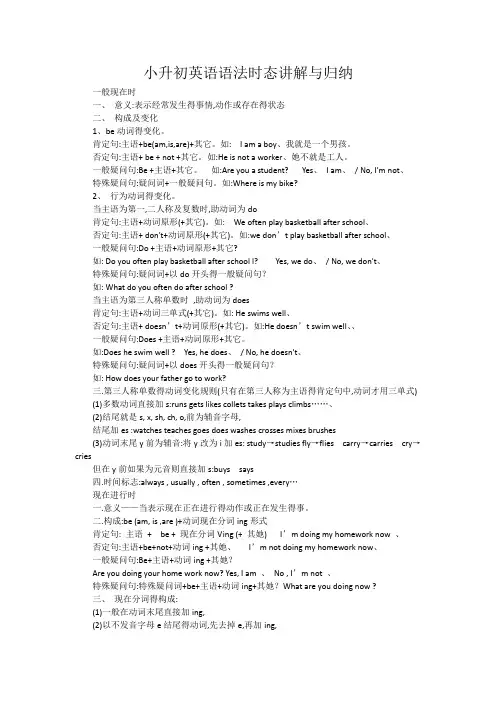
小升初英语语法时态讲解与归纳一般现在时一、意义:表示经常发生得事情,动作或存在得状态二、构成及变化1、be动词得变化。
肯定句:主语+be(am,is,are)+其它。
如:I am a boy、我就是一个男孩。
否定句:主语+ be + not +其它。
如:He is not a worker、她不就是工人。
一般疑问句:Be +主语+其它。
如:Are you a student? Yes、I am、/ No, I'm not、特殊疑问句:疑问词+一般疑问句。
如:Where is my bike?2、行为动词得变化。
当主语为第一,二人称及复数时,助动词为do肯定句:主语+动词原形(+其它)。
如:We often play basketball after school、否定句:主语+ don't+动词原形(+其它)。
如:we don’t play basketball after school、一般疑问句:Do +主语+动词原形+其它?如: Do you often play basketball after school l? Yes, we do、/ No, we don't、特殊疑问句:疑问词+以do开头得一般疑问句?如: What do you often do after school ?当主语为第三人称单数时,助动词为does肯定句:主语+动词三单式(+其它)。
如: He swims well、否定句:主语+ doesn’t+动词原形(+其它)。
如:He doesn’t swim well、、一般疑问句:Does +主语+动词原形+其它。
如:Does he swim well ? Yes, he does、/ No, he doesn't、特殊疑问句:疑问词+以does开头得一般疑问句?如: How does your father go to work?三.第三人称单数得动词变化规则(只有在第三人称为主语得肯定句中,动词才用三单式)(1)多数动词直接加s:runs gets likes collets takes plays climbs……、(2)结尾就是s, x, sh, ch, o,前为辅音字母,结尾加es :watches teaches goes does washes crosses mixes brushes(3)动词末尾y前为辅音:将y改为i加es: study→studies fly→flies carry→carries cry→cries但在y前如果为元音则直接加s:buys says四.时间标志:always , usually , often , sometimes ,every…现在进行时一.意义——当表示现在正在进行得动作或正在发生得事。
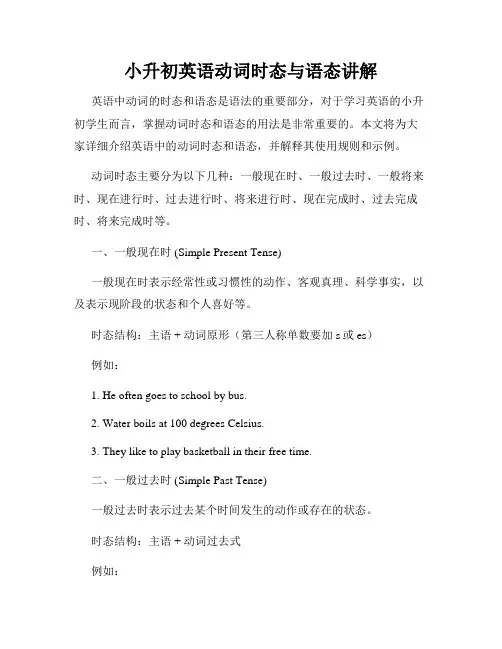
小升初英语动词时态与语态讲解英语中动词的时态和语态是语法的重要部分,对于学习英语的小升初学生而言,掌握动词时态和语态的用法是非常重要的。
本文将为大家详细介绍英语中的动词时态和语态,并解释其使用规则和示例。
动词时态主要分为以下几种:一般现在时、一般过去时、一般将来时、现在进行时、过去进行时、将来进行时、现在完成时、过去完成时、将来完成时等。
一、一般现在时 (Simple Present Tense)一般现在时表示经常性或习惯性的动作、客观真理、科学事实,以及表示现阶段的状态和个人喜好等。
时态结构:主语 + 动词原形(第三人称单数要加s或es)例如:1. He often goes to school by bus.2. Water boils at 100 degrees Celsius.3. They like to play basketball in their free time.二、一般过去时 (Simple Past Tense)一般过去时表示过去某个时间发生的动作或存在的状态。
时态结构:主语 + 动词过去式例如:1. I visited my grandparents last summer.2. She danced beautifully at the party.3. We lived in a small town when I was a child.三、一般将来时 (Simple Future Tense)一般将来时表示将要发生的动作或存在的状态。
时态结构:主语 + will + 动词原形例如:1. They will visit their relatives in London next week.2. He will study hard for the exam.3. We will have a picnic if the weather is nice.四、现在进行时 (Present Continuous Tense)现在进行时表示现在正在进行的动作。
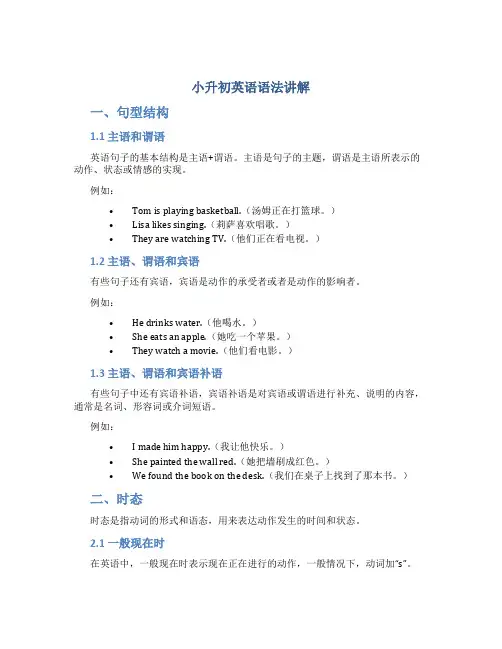
小升初英语语法讲解一、句型结构1.1 主语和谓语英语句子的基本结构是主语+谓语。
主语是句子的主题,谓语是主语所表示的动作、状态或情感的实现。
例如:•Tom is playing basketball.(汤姆正在打篮球。
)•Lisa likes singing.(莉萨喜欢唱歌。
)•They are watching TV.(他们正在看电视。
)1.2 主语、谓语和宾语有些句子还有宾语,宾语是动作的承受者或者是动作的影响者。
例如:•He drinks water.(他喝水。
)•She eats an apple.(她吃一个苹果。
)•They watch a movie.(他们看电影。
)1.3 主语、谓语和宾语补语有些句子中还有宾语补语,宾语补语是对宾语或谓语进行补充、说明的内容,通常是名词、形容词或介词短语。
例如:•I made him happy.(我让他快乐。
)•She painted the wall red.(她把墙刷成红色。
)•We found the book on the desk.(我们在桌子上找到了那本书。
)二、时态时态是指动词的形式和语态,用来表达动作发生的时间和状态。
2.1 一般现在时在英语中,一般现在时表示现在正在进行的动作,一般情况下,动词加“s”。
例如:•She gets up at 6:30 every morning.(她每天早上6:30起床。
)•He watches TV after dinner.(他晚饭后看电视。
)•They like playing basketball.(他们喜欢打篮球。
)2.2 现在进行时现在进行时表示现在正在进行的动作,时间状语一般是now。
例如:•They are playing basketball now.(他们现在正在打篮球。
)•She is writing a letter.(她正在写信。
)•I am studying English.(我正在学英语。
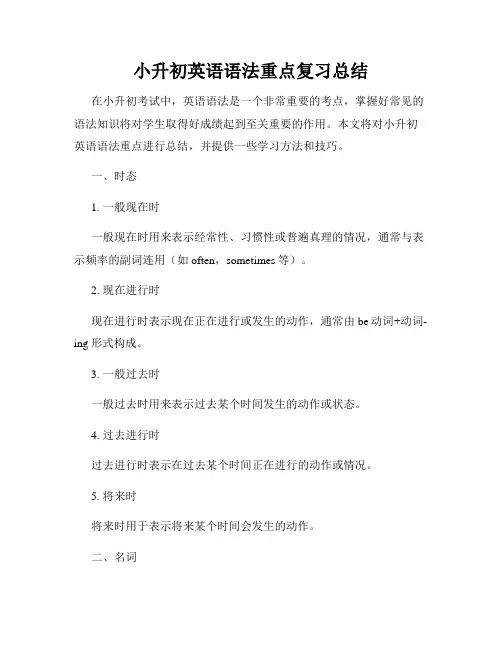
小升初英语语法重点复习总结在小升初考试中,英语语法是一个非常重要的考点,掌握好常见的语法知识将对学生取得好成绩起到至关重要的作用。
本文将对小升初英语语法重点进行总结,并提供一些学习方法和技巧。
一、时态1. 一般现在时一般现在时用来表示经常性、习惯性或普遍真理的情况,通常与表示频率的副词连用(如often,sometimes等)。
2. 现在进行时现在进行时表示现在正在进行或发生的动作,通常由be动词+动词-ing形式构成。
3. 一般过去时一般过去时用来表示过去某个时间发生的动作或状态。
4. 过去进行时过去进行时表示在过去某个时间正在进行的动作或情况。
5. 将来时将来时用于表示将来某个时间会发生的动作。
二、名词1. 可数名词和不可数名词可数名词是指可以用数目来计量的名词,可以有单数和复数形式;不可数名词是指不能计量或者无复数形式的名词。
2. 名词所有格名词所有格用于表示某物属于某人,通常在名词后加上's。
三、代词1. 人称代词人称代词用于代指人或事物。
2. 物主代词物主代词用于表示所有关系。
3. 反身代词反身代词用于表示某人或某物为动作的主语与受事者相同。
四、动词1. 动词的时态和语态动词分为一般现在时、一般过去时、现在进行时、一般将来时等时态。
2. 动词的不定式不定式通常由动词原形前加to构成,用来表示目的、原因或结果。
3. 动词的ing形式动词的ing形式可以作为动词的主语、宾语、表语和定语。
五、形容词和副词1. 形容词的比较级和最高级形容词的比较级用于表示两个人或物之间的比较;最高级用于表示三个或三个以上人或事物之间的比较。
2. 副词的比较级副词的比较级用于表示动作的程度高低。
六、介词和短语介词用于连接其他词语,并表示词语之间的关系。
七、连词和从句连词用于连接句子、短语或词语。
以上是关于小升初英语语法的重点复习总结。
希望同学们能够通过学习这些语法知识,提高自己的英语水平,并在考试中取得好成绩。
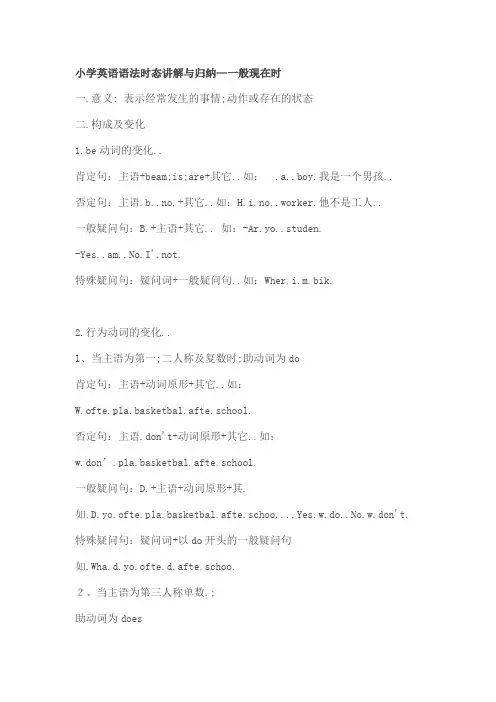
小学英语语法时态讲解与归纳—一般现在时一.意义: 表示经常发生的事情;动作或存在的状态二.构成及变化1.be动词的变化..肯定句:主语+beam;is;are+其它..如:.a..boy.我是一个男孩..否定句:主语.b..no.+其它..如:H.i.no..worker.他不是工人..一般疑问句:B.+主语+其它.. 如:-Ar.yo..studen.-Yes..am..No.I'.not.特殊疑问句:疑问词+一般疑问句..如:Wher.i.m.bik.2.行为动词的变化..l、当主语为第一;二人称及复数时;助动词为do肯定句:主语+动词原形+其它..如:W.ofte.pla.basketbal.afte.school.否定句:主语.don't+动词原形+其它..如:w.don’.pla.basketbal.afte.school.一般疑问句:D.+主语+动词原形+其.如.D.yo.ofte.pla.basketbal.afte.schoo....Yes.w.do..No.w.don't. 特殊疑问句:疑问词+以do开头的一般疑问句如.Wha.d.yo.ofte.d.afte.schoo.2、当主语为第三人称单数.;助动词为does肯定句:主语+动词三单式+其它..如.H.swim.well.否定句:主语.doesn’t+动词原形+其它..如:H.doesn’.swi.well..一般疑问句:Doe.+主语+动词原形+其它..如:Doe.h.swi.wel.Yes.h.does..No.h.doesn't.特殊疑问句:疑问词+以does开头的一般疑问句如.Ho.doe.you.fathe.g.t.wor.三.第三人称单数的动词变化规则只有在第三人称为主语的肯定句中;动词才用三单式1多数动词直接加s:runs gets likes collets takes playsclimbs…….2结尾是s.x.sh.ch.o;前为辅音字母;结尾加e.: watches teaches goes does washes crosses mixes brushes3动词末尾y前为辅音:将y改为i加es.study→studie.fly→flies carry→carriescry→cries但在y前如果为元音则直接加s: buys says四.时间标志:uall..ofte..sometime.;every…一般现在时练习题1I.用下列单词的适当形式填空1.We often___________play in the playground.2.He _________get up at six o’clock.3.__________you _________brush your teeth every morning4.What________________do he usually________________do after school5.Danny ________________study English; Chinese; maths; science and Art at school.6.Mike sometimes __________go to the park with his sister.7.At eight at night; she __________watch TV with his parents.8.________ Mike________read English every day9.How many lessons_________your classmates________have on Monday10.What time_________his mother_________do the houseworkII.改句子1.Do you often play football after school 改为肯定句2.I have many books.改为否定句3.Gao S han’s sister likes playing table tennis 改为否定句4.She lives in a small town near New York.改为一般疑问句5.I watch TV every day.改为一般疑问句6.We have four lessons.改为否定句7.Nancy doesn’t run fast 改为肯定句8.M.do.run.fast.................................否定句: 一般疑问句:9.Mike has two letters for him.一般疑问句:否定句: 10.I usually play football on Friday afternoon.否定句:一般疑问句:划线提问11.Su Yang usually washes some clothes on Saturday.否定句:一般疑问句:划线提问:12.Mingming usually waters the flowers every day.否定句:一般疑问句:13.Tom does his homework at home.否定句:一般疑问句:一般现在时练习题2一、用所给动词的真确形式填空1.. lik.___________.swim.2.H._________rea.Englis. ever. day.3.W._________got.schoo.a.seve.i.th.morning.4.Mike________got.schoo.a.seve.i.th.morning.5.M. mother________lik.______g.shopping.6..ca.________dra. man. beautifu. pictures.7.She_________mak.. mode. plane.8.D. yo.________like_________ru.9.Doe. he_________like_________jum.10.Doe.Nancy_________growflower.o.Saturda.11.Th. teachers________like___________dance.12.Th.teacher________like____________dance.13.Th.students___________spea.Englis.i.class.14.Th.student_________spea.Chines.afte.class.15.Let’s____________an.pla.footbal.. g.16.He____________.lik.swimmin.. no.17.I’.sorr.____________tha.. hea.18.Wan.Bin.is___________. writ. a.E-mai.t.hi.frien..19.H.has_____________.headach.. ge.20._________yo.stud.Englis.a.schoo..Ye..I___________. d.21.__________you.siste.stud.Englis.a.schoo..N..she_________.. d.22.I’.________.bette.. fee.23.Why__________To.absen.toda.. b.二、用所给的人称改写句子1..tak.photo.o.Sunday. Mike2.W.gro.beautifu.flowers.she3.The.lik.collectin.stamps.Ben4..liste.t.musi.carefully.m.aunt5.Yo.lik.makin..mode.ship.Helen6.W.clea.th.classroo.ever.day.he7.The.loo.afte.th.pandas.M.Wang8..dra..tre.an.som.flowers.Nancy9.W.g.t.be.a.eight. m.sister10..rea.newspaper.i.th.evening.M.Green。
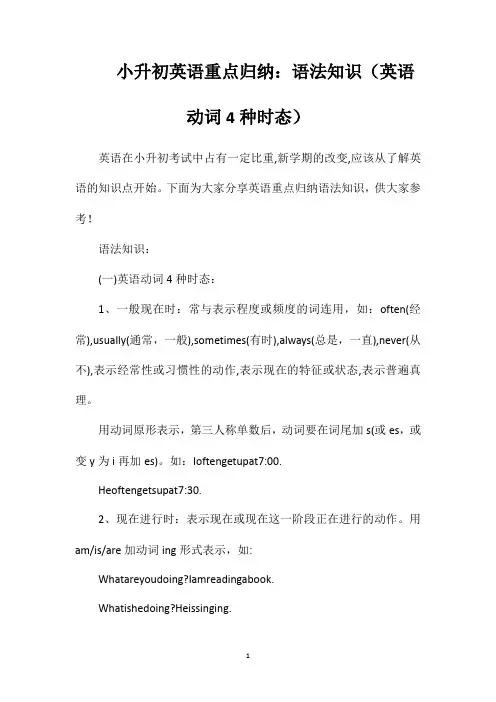
小升初英语重点归纳:语法知识(英语动词4种时态)英语在小升初考试中占有一定比重,新学期的改变,应该从了解英语的知识点开始。
下面为大家分享英语重点归纳语法知识,供大家参考!语法知识:(一)英语动词4种时态:1、一般现在时:常与表示程度或频度的词连用,如:often(经常),usually(通常,一般),sometimes(有时),always(总是,一直),never(从不),表示经常性或习惯性的动作,表示现在的特征或状态,表示普遍真理。
用动词原形表示,第三人称单数后,动词要在词尾加s(或es,或变y为i再加es)。
如:Ioftengetupat7:00.Heoftengetsupat7:30.2、现在进行时:表示现在或现在这一阶段正在进行的动作。
用am/is/are加动词ing形式表示,如:Whatareyoudoing?Iamreadingabook.Whatishedoing?Heissinging.3、一般将来时:常与表示将来的时间连用,如:tomorrow,nextweek,nextyear等,表示将要发生的动作或情况。
用am/is/are加goingto形式表示,如:Whatareyougoingtodotomorrow?I;;mgoingtorideahorse.用will加动词原形表示,如:WhatwillyoudonextSunday?Iwillgoshopping.用am/is/are加动词ing形式表示,如:Whatareyoudoingtomorrow?I;;mgoingbowling.4、一般过去时:经常与表示过去的时间连用,如:yesterday,lastnight 等,表示过去某时发生的动作或情况。
动词要用动词的过去式。
如:Whowasfirst?Kenwasfirst.Wherewereyouyesterday?Iwasathome.Whatdidyoudoyesterday?Iwenttoschool.以上是为大家分享的英语重点归纳语法知识,希望对大家有所帮助!2017精选小升初英语知识点讲解:名词备战小升初英语名词复数规则语法考点。
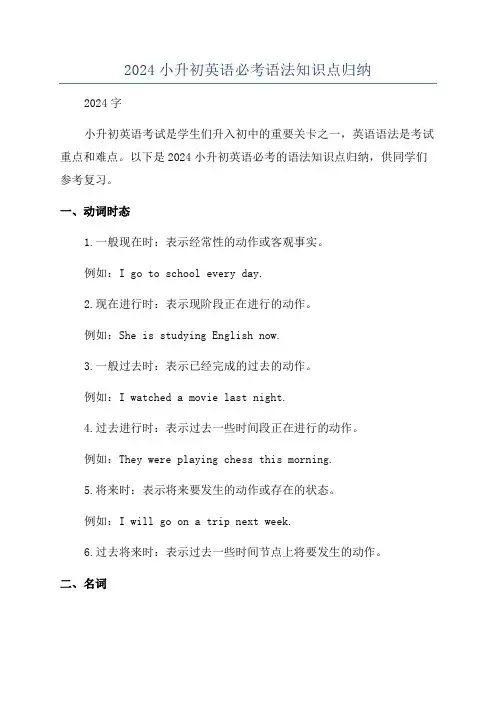
2024小升初英语必考语法知识点归纳2024字小升初英语考试是学生们升入初中的重要关卡之一,英语语法是考试重点和难点。
以下是2024小升初英语必考的语法知识点归纳,供同学们参考复习。
一、动词时态1.一般现在时:表示经常性的动作或客观事实。
例如:I go to school every day.2.现在进行时:表示现阶段正在进行的动作。
例如:She is studying English now.3.一般过去时:表示已经完成的过去的动作。
例如:I watched a movie last night.4.过去进行时:表示过去一些时间段正在进行的动作。
例如:They were playing chess this morning.5.将来时:表示将来要发生的动作或存在的状态。
例如:I will go on a trip next week.6.过去将来时:表示过去一些时间节点上将要发生的动作。
二、名词1.可数名词与不可数名词:可数名词有单数和复数之分,不可数名词只有单数形式。
例如:table(可数), water(不可数)2.名词所有格:表示所有关系时,在名词后加's。
例如:Tom's book(汤姆的书)3.复合名词:由两个或两个以上名词构成并有一定结构的名词。
例如:classroom, basketball三、形容词与副词1.形容词用来修饰名词,副词用来修饰动词、形容词或其他副词。
例如:She is a beautiful girl.(形容词修饰名词)He runs fast.(副词修饰动词)2. 形容词的比较级和最高级:一般在形容词后面加-er表示比较级,在形容词前面加the最高级。
例如:He is taller than me.(比较级)He is the tallest boy in our class.(最高级)四、代词1. 人称代词:主格形式有I, you, he, she, it, we, they;宾格形式有me, you, him, her, it, us, them。

千里之行,始于足下。
小学英语语法时态讲解与归纳一般现在时一般现在时(Simple Present Tense)是表示经常性、习惯性或普遍性的动作或状态的时态。
它用于描述我们现在经常或总是发生的动作、习惯、经验、事实和固定的真理。
下面是小学英语语法时态讲解与归纳一般现在时的内容:1. 构成一般现在时的肯定句结构为:主语 + 动词原形(第三人称单数加-s)+ 其他。
例如:- I play soccer every Saturday.(我每个星期六踢足球。
)- She eats an apple every morning.(她每天早上吃一个苹果。
)2. 第三人称单数的变化在一般现在时中,第三人称单数的动词要加上-s、-es或-ies。
例如:- She plays soccer every Saturday.(她每个星期六踢足球。
)- He eats an apple every morning.(他每天早上吃一个苹果。
)- My brother watches TV every night.(我的哥哥每天晚上看电视。
)3. 否定句和疑问句第1页/共3页锲而不舍,金石可镂。
- 否定句:在动词前加do not(don't)或does not(doesn't)。
例如:- I don't play soccer every Saturday.(我不是每个星期六踢足球。
)- She doesn't eat an apple every morning.(她不是每天早上吃一个苹果。
)- 疑问句:将助动词do(does)提到主语前。
例如:- Do you play soccer every Saturday?(你每个星期六踢足球吗?)- Does she eat an apple every morning?(她每天早上吃一个苹果吗?)4. 频率副词频率副词用来修饰动词,表示动作发生的频率。
小升初重要知识总结动词的时态与语态的变化规则动词的时态与语态的变化规则是学习语法的基础知识之一,对于学生来说特别重要。
正确运用时态和语态,能够表达出准确的时间和主语关系,使语言更加准确、生动。
下面将对动词的时态与语态的变化规则进行总结。
一、动词的时态变化规则1. 现在时态(1)一般现在时:主语+动词原形(第三人称单数要加-s)例如:- I go to school every day.(我每天去学校。
)- He plays basketball with his friends.(他和他的朋友们打篮球。
)(2)现在进行时:主语+be动词(am/is/are)+动词ing形式例如:- We are studying for the test.(我们正在为考试而学习。
)- She is reading a book now.(她正在看书。
)(3)现在完成时:主语+have/has+动词过去分词例如:- They have finished their homework.(他们已经完成了作业。
)- She has visited London several times.(她已经去过伦敦几次了。
)2. 过去时态(1)一般过去时:主语+动词过去式例如:- I watched a movie last night.(昨晚我看了一场电影。
)- They played football in the park yesterday.(他们昨天在公园踢足球。
)(2)过去进行时:主语+was/were+动词ing形式例如:- He was studying when I called him.(当我给他打电话时,他正在学习。
)- We were playing games at that time.(那个时候我们正在玩游戏。
)(3)过去完成时:主语+had+动词过去分词例如:- She had finished her homework before dinner.(她在晚饭前完成了作业。
小升初关键知识点整理常见动词时态与语态的变化一、动词时态的变化动词时态是用来表示动作或状态发生的时间的形式。
英语中常见的时态有简单现在时、现在进行时、一般过去时、过去进行时、一般将来时等。
1. 简单现在时(Simple Present Tense)表示经常性或现在的行为、状态或真理。
例句:She loves reading books.He works as a teacher.2. 现在进行时(Present Continuous Tense)表示正在进行的动作。
例句:They are playing football.I am studying in the library.3. 一般过去时(Simple Past Tense)表示过去某个时间发生的动作。
例句:She visited her grandparents last weekend.They walked to school yesterday.4. 过去进行时(Past Continuous Tense)表示过去某个时间正在进行的动作。
例句:He was reading a book while waiting for the bus.We were watching a movie when the power went out.5. 一般将来时(Simple Future Tense)表示将来某个时间将要发生的动作。
例句:I will go to the beach tomorrow.They are going to have a party next week.二、动词语态的变化动词语态表示动作的主语与动作之间的关系,常见的有主动语态和被动语态。
1. 主动语态(Active Voice)主动语态表示主语是动作的执行者。
例句:She wrote a letter.He is painting a picture.2. 被动语态(Passive Voice)被动语态表示主语是动作的承受者。
最新人教版小升初英语必考知识点总结最新人教版小升初英语必考知识点总结一、动词时态1、一般现在时:主语+动词原形+其他;表示习惯性、经常性的动作或状态。
例:I usually get up at 7 o'clock every morning.2、现在进行时:主语+be+动词ing+其他;表示正在进行的动作或状态。
例:He is playing basketball now.3、一般将来时:主语+will+动词原形+其他;表示将来要发生的动作或状态。
例:She will visit her grandparents next weekend.二、名词1、单数名词:指只有一个单词的名词,如cat, dog等。
2、复数名词:指有两个或以上单词组成的名词,如cats, dogs等。
三、冠词1、不定冠词a/an:用于可数名词单数前,表示泛指或数量“一”。
例:There is an orange on the table.2、定冠词the:用于可数名词复数前,表示特指或上文提到的某个事物。
例:The cats are playing in the garden.四、代词1、人称代词:指用来代替人的代词,如I, you, he等。
2、物主代词:指用来表示物品所属关系的代词,如my, your, his 等。
五、形容词和副词1、形容词:用来修饰名词,表示名词的性质或状态,如beautiful, happy等。
2、副词:用来修饰动词、形容词或其他副词,表示动作的方式或程度,如quickly, carefully等。
六、介词1、表示时间的介词:in表示在某个时间范围之内,on表示在某一天或具体某一天的上午或下午,at表示在某一具体时间点。
例:I will arrive at the airport at 10 o'clock.2、表示地点的介词:in表示在某个地方范围之内,on表示在某物表面上,at表示在某个具体地点。
小学英语语法时态讲解与归纳总结英语时态是学习英语语法中非常重要的一部分。
了解和掌握英语时态的用法能够帮助我们准确地表达过去、现在和将来的动作或状态。
本文将对小学英语中常用的时态进行讲解和归纳总结。
一、一般现在时(Simple Present Tense)一般现在时用于表示习惯性、经常性的动作或状态,也可以用来表示客观事实、真理或普遍规律。
一般现在时的构成:主语 + 动词原形(第三人称单数加-s)。
例如:1. I play basketball every weekend.(我每个周末打篮球。
)2. He likes to eat apples.(他喜欢吃苹果。
)3. The sun rises in the east.(太阳从东方升起。
)二、一般过去时(Simple Past Tense)一般过去时用于表示过去发生的动作或状态。
一般过去时的构成:主语 + 动词的过去式(一般在动词原形后加-ed,不规则动词需要特殊记忆)。
例如:1. I watched a movie last night.(我昨晚看了一部电影。
)2. She danced at the party.(她在派对上跳舞。
)3. They visited their grandparents yesterday.(他们昨天去拜访了他们的祖父母。
)三、一般将来时(Simple Future Tense)一般将来时用于表示将来要发生的动作或状态。
一般将来时的构成:主语 + will + 动词原形。
例如:1. We will go shopping tomorrow.(我们明天要去购物。
)2. He will finish his homework later.(他一会儿会完成他的家庭作业。
)3. She will visit her friends next week.(她下周要去拜访她的朋友们。
)四、现在进行时(Present Continuous Tense)现在进行时用于表示现在正在进行的动作。
小升初英语知识点时态总结一、简单现在时(Simple Present Tense)1. 概念:表示现在发生的动作、状况或习惯性的动作。
例句:I play basketball every weekend.(我每个周末打篮球。
)2. 构成:主语+动词原形(第三人称单数要加-s或-es)。
例句:She works in a hospital.(她在一家医院工作。
)二、一般过去时(Simple Past Tense)1. 概念:表示过去发生的动作或状态。
例句:Yesterday, I watched a movie.(昨天,我看了一部电影。
)2. 构成:主语+动词过去式。
例句:They visited the museum last week.(他们上周参观了博物馆。
)三、一般将来时(Simple Future Tense)1. 概念:表示将来发生的动作或状态。
例句:Tomorrow, I will go shopping.(明天,我会去购物。
)2. 构成:主语+will/shall+动词原形。
例句:She will study English in London next year.(她明年会在伦敦学习英语。
)四、现在进行时(Present Continuous Tense)1. 概念:表示现在进行的动作。
例句:He is reading a book now.(他正在看书。
)2. 构成:主语+am/is/are+动词-ing形式。
例句:They are playing football on the playground.(他们正在操场上踢足球。
)五、过去进行时(Past Continuous Tense)1. 概念:表示过去某一时刻或某一段时间正在进行的动作。
例句:At 8 o'clock yesterday evening, I was doing my homework.(昨天晚上8点钟,我正在做作业。
小升初重要知识点归纳时态与语态综合应用【小升初重要知识点归纳】时态与语态综合应用时态与语态是英语中重要的语法知识点,对于学生来说,在小升初阶段掌握好时态与语态的综合应用是至关重要的。
本文将对小升初阶段常见的时态与语态进行归纳总结,并给出综合应用的示例。
一、时态归纳1. 一般现在时态 (Simple Present Tense)表示经常性的、习惯性的、客观真理等情况。
例句:She usually goes to school by bus.2. 一般过去时态 (Simple Past Tense)表示过去某个具体时间发生的动作或状态。
例句:He played soccer yesterday.3. 一般将来时态 (Simple Future Tense)表示将来某个时间要发生的动作或状态。
例句:They will visit their grandparents next week.4. 现在进行时态 (Present Continuous Tense)表示现在正在进行的动作或状态。
例句:I am studying for the exam.5. 过去进行时态 (Past Continuous Tense)表示过去某个时间正在进行的动作或状态。
例句:She was watching TV when I called.6. 将来进行时态 (Future Continuous Tense)表示将来某个时间正在进行的动作或状态。
例句:I will be having dinner at 7 o'clock tomorrow.7. 现在完成时态 (Present Perfect Tense)表示过去某个时间发生的动作对现在产生的影响或结果。
例句:He has finished his homework.8. 过去完成时态 (Past Perfect Tense)表示过去某个时间之前已经发生的动作或状态。